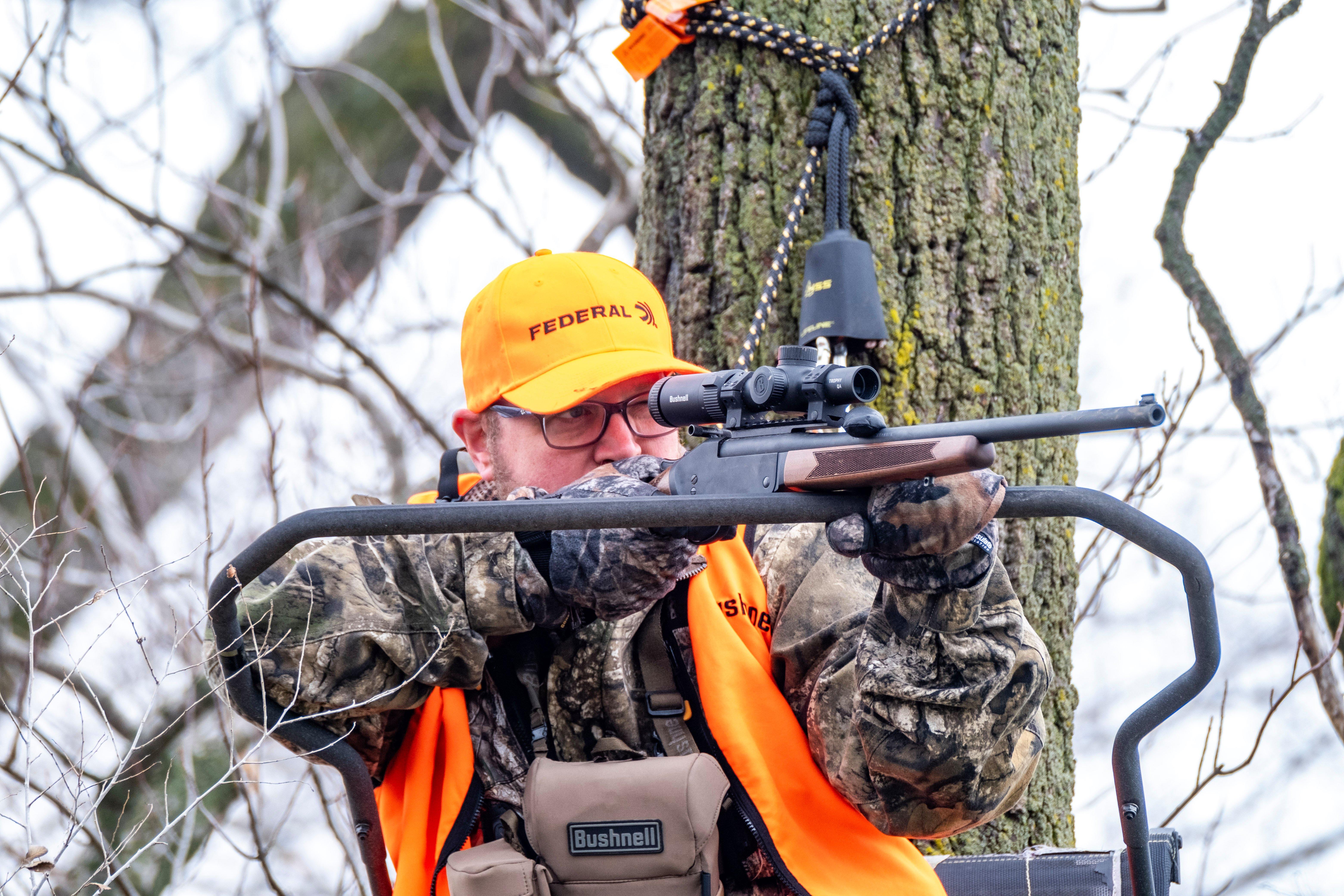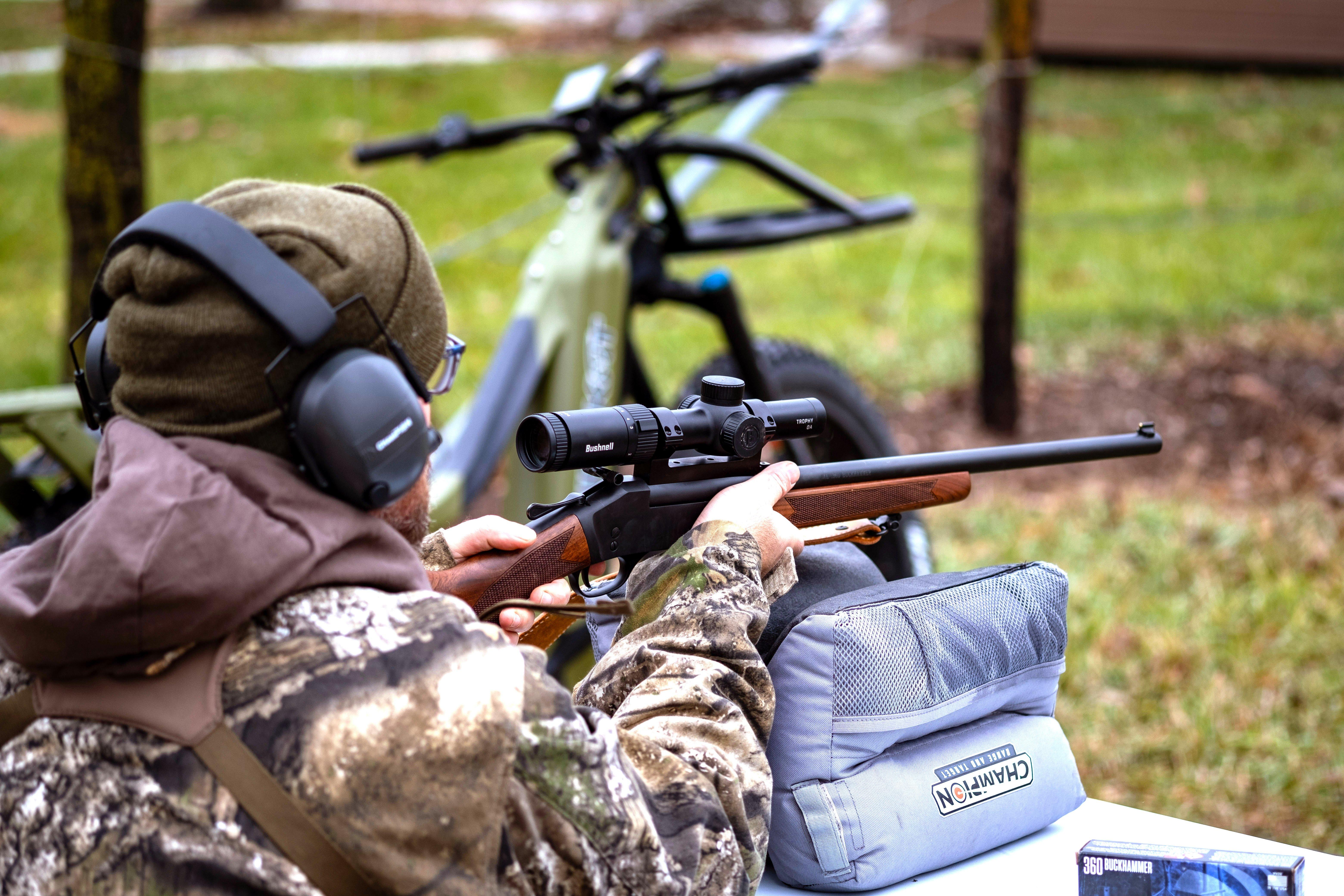LPVOs aren’t just for ARs and 3-gun competitions. Here’s why you should consider one for your hunting rifle

An LPVO handles nicely and provides fast target acquisition in the deer woods. Image by Justin Moore / Danger Soup
Recently, I went to a media event at the Sierra Bullet factory. We spent part of our time there at the range, testing Sierra bullets and ammunition out to 2,000 yards. Along with seeing the ammunition perform flawlessly, I picked up some shooting tips from a former Ranger Sniper and Sierra ballistician, Kyle Edwards. What struck me most about Edwards’ “long range” rifle was his Army-issue fixed 10-power scope. I’ve been shooting long range for about two years now, and I’ve never seen anyone limit themselves to 10 power for shots out past 1,000 yards. I jumped behind Edwards’ rig to give it a try and realized immediately why he leaned toward lower magnification. It worked better than shooting with the telescopes I’d used before.
First, I was able to see my misses and adjust quickly. The recoil affected me less. Second, I had a wider field of view, which is more important than you think. With Edwards backing me up as a spotter, I could hit everything inside of 1,000 yards — and this got me thinking. With hunting shot distances usually hovering around 300 yards and in, why are we putting 12-, 14-, or even 18-power scopes on our rifles? When I got home, I dug a little deeper, reading into classic hunting and shooting books from the 1950s, ’60s, and '70s.
What I found is when hunters scoped their rifles back then, they used lower-powered optics. This is partially due to optics technology not being what it is today. It also may have to do with the idea that more magnification is better. But that’s not always the case. Old-school hunters not only got the job done with 2x, 4x, and 6x scopes, they were more prepared for shots at close range. Best of all, they weren’t burdened with heavy rifles and optics, letting them cover more ground without getting fatigued. Today, there are a lot of low-powered variable scopes (LPVOs) on the market for AR shooters. They offer everything you’d need to shoot a deer at 25 yards or 325 yards. Here’s a few reasons why you might want to give one a try.
What is an LPVO?
LPVO scopes typically have a power range from 1-10x, though some are only 1-4x. Many of them come with illuminated reticles and bullet drop compensation hash marks geared to the .223 Remington. But there are many with simple crosshairs and dialing turrets. They offer slightly longer eye relief than most traditional hunting scopes, giving a shooter better awareness of their surroundings. LPVOs also have a smaller objective lens, which means they can be mounted low to the rifle and still clear things like iron sights.
So, How Does all of This Benefit the Hunter?
It’s no secret that the rifle hunting world is being driven by long range shooting right now. But take a minute and think about the shots you’re presented with most in the field. Eastern hunters from north to south take most of their shots in the woods at around 100 yards and under. They also have a tendency to jump deer or be presented with a quick off-hand shot if they’re hunting on foot. For these shots, you don’t want any more magnification than 6 power.
Hunters out West often get close shots, too. On my last mule deer hunt, I had prepared for a cross canyon shot at a buck, only to shoot my deer at 80 yards in the timber. I only had about five seconds to throw my rifle up and shoot, and I was happy my scope was set to 3x when I did. Had I been presented with a 300-yard shot, I could have taken it on 8x or 10x. And even if I had an LPVO maxed out on magnification, I still could have made my 80-yard split-second shot.
What LPVOs give you is less tunnel vision and less room for user error. How many times have you been surprised by a deer, thrown your rifle up, and fiddled with the magnification trying to find him again? For shots like that, seconds matter, not magnification. Don’t get caught over-scoped.
LPVOs are also lighter than traditional rifle scopes. This might not mean a lot to the treestand hunter, but for still hunters and mountain hunters, weight matters a lot. The less you have to think about hauling a heavy rifle, the more time you have to focus on looking for game.
The last benefit an LPVO can give you is illumination and extremely low power. This past season, I’ve tried my hand at buck tracking, where a hunter follows the tracks of a whitetail in the snow, hoping to get a quick shot at him when he jumps out of his bed. In talking to many buck trackers, I’ve found that they’re all ready to shoot a deer on the run. You might not be, and there’s nothing wrong with that. But think about cases when you’ve wounded a deer and need to follow him up. You might only have a running shot, and in that case, you need to take it. Using a scope on 1x with a red dot is just the tool for the job.
Don’t Miss: ARE NEIGHBORHOOD DOGS RUNNING DEER? WHAT HUNTERS CAN DO

Most LPVOs offer illuminated reticles at extremely low power, ideal for quick shots in the timber. Image by Justin Moore / Danger Soup
What about taking longer shots with an LPVO?
Hunters with LPVOs should approach their shooting a little differently than those with traditional scopes. First, you need to practice. It’s important to get comfortable with your setup. Try to find a range that allows you to shoot longer distances. You also want to establish how far you’re comfortable shooting and stick to it. Stick to distances where you’re getting hits 95-100 percent of the time on kill-zone-sized targets, and keep that distance in mind when you’re in the field.
What you’ll gain by shooting at low power at distance all comes after the shot. You might see a bullet hit the dirt near your target and be able to adjust quickly for a follow-up. Recoil will have less of a chance to throw you off, too. You can see how the animal reacts to your shot and get a good line of sight on where it runs if it does.
LPVOs are also versatile
Rimfires, turkey guns, hog-hunting rifles, and dangerous game guns can all benefit from an LPVO, making these optics an extremely versatile. If you can’t afford to fit all of your guns with an LPVO, you can get quick-detach scope mounts and switch back and forth depending on the season. For spring gobblers, you can sight in your shotgun and run the optic on 1x to 3x with a red dot. When deer season rolls around, you can put in on a bolt-action or lever-gun and hit the woods.
Some Great LPVO Scopes for Hunters
If you’re ready to make the switch, these LPVO scopes have it all, from BDC turrets to illumination. Some are better for close range snap shooting, while others should have you covered out to most reasonable hunting distances. Best of all, none of the reticles below are overly busy, which is common on many LVPOs used on ARs for competition. Instead, they offer simple, straightforward aiming systems that, with practice, can help you range and hit targets.
Don’t Miss: HOW TO SNOW TRACK A BIG WOODS BUCK

LPVOs are a perfect fit for straight-wall cartridges. Image by Justin Moore / Danger Soup
Bushnell Trophy Quick Acquisition 1-6x24
At just under $200, you’d be hard-pressed to find a better bargain for an LPVO than the Bushnell Trophy Quick Acquisition. This riflescope is also illuminated, giving you a bright aiming point on low or high power. It also has 2 MOA holdovers for elevation, should you need to take a longer shot. The best thing about having standard holdovers like these vs. a BDC reticle tuned to a specific cartridge is that you can gather data for whatever cartridge you shoot. It’s a solid option for those who hunt in straight-wall-only states, shotgun only counties, or anybody else who wants to run a lightweight, low-powered optic.
Trijicon AccuPoint 1-6x24
When most think of Trijicon, they think of the ACOG and RMR. But this company makes an expansive line of hunting optics, too. Best of all, they’ve borrowed technology from their ACOG for scopes like the AccuPoint. The illumination in the AccuPoint doesn’t require batteries. The 1-6x24 also has a variety of reticle options. I personally like the mil-dot reticle because it gives you solid holdovers for any cartridge. The capped turrets on the AccuPoint are also easily adjustable for longer shots. And in the woods, it functions like a red or green-dot sight on 1X for fast shooting.
Tract TORIC UHD 1-8x24 MRAD 30mm
The TORIC’s 1-8 power range is great for hunting rifles. At the low end, you’re basically using a red-dot sight. At the high end, you’re close to the top-level magnification of a classic 3-9 hunting scope. The TORIC has extremely smooth controls for both the magnification ring and turrets. Its turrets are capped, so you don’t need to worry about coming off of zero should you bump your rifle. But when you need to dial for a longer shot, they’re easily adjustable by hand. On the highest magnification, the TORIC’s MRAD reticle (MOA is available, too) can be used for holdovers or to estimate the range to your target. Tract also offers a great lifetime warranty to your scope, so you’ll never have to worry about breaking it.
VX-3HD 1.5-5X20 CDS-ZL ILLUM. FIREDOT TWILIGHT HUNTER
The VX-3HD is one of many solid LPVOs Leupold offers for everything from ARs to dangerous game rifles. As far as price, it comes in right in the middle of the pack at around $700. But it packs in some features that are found on higher-end optics. First is Leupold’s CDS Zerolock turret. These turrets are easy to turn on the fly and lock in place securely when back on zero. The reticle on the VX-3HD is simple and easy to pick up for fast shooting. It’s also illuminated with a red dot in the center. If you’re switching to an LPVO to save weight, this is your scope. It’s extremely lightweight at only 12 ounces.
Don’t Miss: STILL-HUNTING HOTSPOTS FOR LATE-SEASON BUCKS











